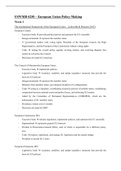FSWMB-4250 – European Union Policy-Making
Week 1
The Institutional Framework of the European Union – Lelieveldt & Princen (2015)
European Council
- Executive body provides political power and represent the EU externally
- Intergovernmental represent the member states
- 27 government leaders with voting rights; President of the European Council, the High
Representative, and the President of the Commission without voting rights
- Tasks setting the overall policy agenda, revising treaties, and resolving disputes that
cannot be solved by the Council
- Decisions are made by Consensus
The Council of Ministers/the European Union
- Executive body implements policies
- Legislative body examines, modifies, and adopts legislative measures that provide the
basis for EU-policies
- Intergovernmental represent the member states
- Ministers from member states’ governments divided in 10 configurations
- Tasks acting as a legislator, coordinating economic policies of member states, coordinating
cooperation between national courts and police forces, and reforming EU-treaties
- Aided by the Committee of Permanent Representatives (COREPER), which are the
ambassadors of EU member states
- Presidency rotates every 6 months
- Decisions are made by QMV
European Commission (EC)
- Executive body initiates legislation, implements policies, and represent the EU externally
- Supranational represents general EU-interests
- Divided in Directorates-General (DGs), each of which is responsible for a different policy
area
- Tasks propose, implement, and manage EU legislation and the annual budget
- President is elected for 5 years
European Parliament (EP)
- Legislative body examines, modifies, and adopts legislative measures that provide the
basis for EU-policies
, - Supranational represents EU citizens based on their ideology
- 706 MEPs, directly elected for 5 years
- Tasks amending and adopting EU legislation and the budget, and monitoring the work of
other EU institutions
- President is elected by MEPs for 2 ½ years
- EP elects the president of the Commission, and can censure the Commission by a 2/3 majority
Court of Justice of the European Union (CJEU)
- Judicial body interprets EU law and adjudicates in conflicts involving EU institutions,
member states, and other involved parties
- Supranational represent the general EU-interest
- 1 judge per member state, assisted by 11 advocates-general, and the General Court
- Tasks making sure that EU law is interpret and applied in the same way, and judicial
review of EU-treaties
The Political System of the European Union – Hix (2005
Actors are rational. They have a clear set of preferences about what outcomes they want from the
political process. Actors act upon these preferences. Institutions are the main constraints on actors’
behavior. Institutions determine the likely payoff from actions.
Preferences + Institutions = Outcomes
Politics is an ongoing, dynamic process. Actors attempt to maximize their preferences within a set of
institutional constraints and a structure of strategic interests. Some actors change preferences, but
actors can collectively change institutions. Once an equilibrium has been reached, these institutions
are often locked in. Therefore, politics is often path-dependent.
The Political System of the European Union – Lelieveldt & Princen (2022)
Chapter 1 – Introduction: explaining the EU political system
4 characteristics of a political system:
1. A stable and clearly defined set of institutions
2. Citizens seek to realize their political desires through the political system
3. Decisions in the political system have an impact on the distribution of economic resources
and the allocation of values
4. Continuous interaction between political outputs and demands
The EU is a decentralized political system.
, The initial driving force of the EU after 2 world wars was peace and reconciliation. Today, the EU is a
response to 2 logics:
1. Economic logic pushing the world towards larger economic
2. Political logic pushing societies towards more decentralized decision-making
Exclusive EU competences:
- Regulation of the Single Market
- Custom union and external trade policies
- Monetary policy for member states with the Euro
- Price setting and subsidy of production under the Common Agriculture Policy and Common
Fisheries Policy
Shared EU and member state competences
- Social and environmental regulation
- Consumer protection and common public health concerns
- Economic, social, and territorial cohesion
- Transport and free movement of persons
- Energy
Coordinated competences
- Macro-economic policies
- Foreign and defense policies
- Policing and criminal justice policies
- Policies regarding health, education, culture, tourism, youth, sport, and vocational training
Exclusive member state competences
- All other policies e.g., taxation and public spending
The EU doesn’t have a constitution, but a constitutional architecture that determines the policy
competences and institutional powers in the EU.
There is a democratic deficit in the EU, because governments delegated power from the national level
to the European level, but policy-making has become more isolated from domestic public opinions
and national parliaments.
Most important EU treaties:





